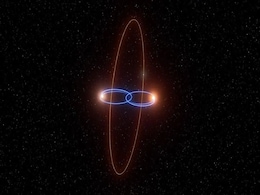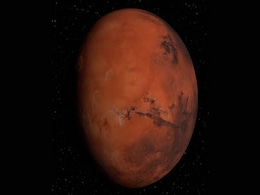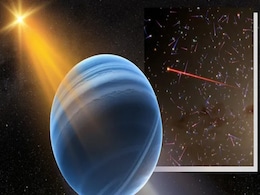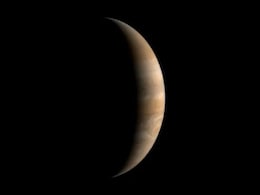Planet Orbits
- All
- News
-

Bizzare 'Failed Star' Planet Orbiting Double Star System in Milky Way Discovered by Researchers
- Thursday April 17, 2025
- Written by Gadgets 360 Staff
Astronomers have discovered an exoplanet 90 degrees tilted around a special pair of eclipsing brown dwarfs. This uncommon "polar planet" challenges accepted wisdom on planet creation by presenting new insights on the dynamics of binary stars and the range of Milky Way planetary orbits.
-
 www.gadgets360.com
www.gadgets360.com
-

This New Telescope Can Negate 'False-Positives' Of Alien Life Within Hours
- Friday April 4, 2025
- Science | Edited by Abhinav Singh
The ELT could identify biosignatures on planets in our solar system as well as orbiting Proxima Centauri within hours.
-
 www.ndtv.com
www.ndtv.com
-

SpaceX Shares First-Ever View Of Earth's Poles From Space, Elon Musk Reacts
- Wednesday April 2, 2025
- Science | Edited by Ritu Singh
The crew is capturing breathtaking views of our planet's most remote regions on the SpaceX Crew Dragon Resilience.
-
 www.ndtv.com
www.ndtv.com
-

Two New Exoplanets Found Orbiting a Star in Draco Constellation
- Wednesday April 2, 2025
- Written by Gadgets 360 Staff
Astronomers have identified two exoplanets, TOI-1453 b and TOI-1453 c, orbiting a star 250 light-years away in Draco. The planets, a super-Earth and a sub-Neptune, were detected using NASA’s TESS satellite and the HARPS-N spectrograph. TOI-1453 b is a rocky planet orbiting close to its star, while TOI-1453 c is twice Earth’s size and may have a...
-
 www.gadgets360.com
www.gadgets360.com
-

Alien Life May Survive on Planets Orbiting White Dwarfs, Study Finds
- Wednesday March 26, 2025
- Written by Gadgets 360 Staff
New research explores the possibility of alien life on planets orbiting white dwarfs. While these stellar remnants cool over time, their shrinking habitable zones may still allow biological processes like photosynthesis and UV-driven abiogenesis to occur. A model assessing a planet's energy reception over seven billion years indicates that life-sus...
-
 www.gadgets360.com
www.gadgets360.com
-

4 Planets Found Orbiting Earth's Nearest Star. They Are Too Hot For Life
- Wednesday March 12, 2025
- World News | Asian News International
Astronomers have revealed new evidence that there are not just one but four tiny planets circling around Barnard's Star, the second-nearest star system to Earth.
-
 www.ndtv.com
www.ndtv.com
-

New Research Reveals Mars’ Red Colour Linked to Ancient Water Presence
- Monday March 3, 2025
- Written by Gadgets 360 Staff
A recent study suggests that Mars’ red hue originates from ferrihydrite, an iron oxide that forms in water-rich environments. Scientists recreated Martian dust in labs and found that the mineral remained stable despite the planet’s dry conditions. Data from orbiting spacecraft and rovers confirm this discovery, reshaping theories about Mars’ ...
-
 www.gadgets360.com
www.gadgets360.com
-

A Neptune-Like Exoplanet Is Racing Through Space at Record Speed
- Monday February 17, 2025
- Written by Gadgets 360 Staff
Scientists have detected an exoplanet racing through space at 1.2 million mph, making it the fastest known planet. The Neptune-sized world orbits a hypervelocity star, first hinted at in 2011 via gravitational microlensing. Astronomers, using Keck Observatory and Gaia data, have confirmed the system’s extreme speed, suggesting it may even leave t...
-
 www.gadgets360.com
www.gadgets360.com
-

Astronomers Spot a High-Speed Star That May Carry a Planet With It
- Friday February 14, 2025
- Written by Gadgets 360 Staff
Astronomers have identified a celestial object moving through the Milky Way at over 1.2 million mph. Believed to be a small star with a possible massive exoplanet, the discovery could mark the fastest-known planetary system. If its speed exceeds 1.3 million mph, it may eventually escape the galaxy. Scientists are still verifying whether it is the s...
-
 www.gadgets360.com
www.gadgets360.com
-

A Star With a Planet May Be Racing Through the Galaxy at Record Speed
- Wednesday February 12, 2025
- Written by Gadgets 360 Staff
Astronomers have identified a potential record-breaking exoplanet system moving at 1.2 million mph. Detected through microlensing, the discovery suggests a low-mass star with an orbiting planet is racing through the Milky Way. Data from the Keck Observatory and ESA’s Gaia satellite indicate a high-speed celestial body that may eventually escape t...
-
 www.gadgets360.com
www.gadgets360.com
-

Newly Confirmed Super-Earth HD 20794 d May Support Life in Habitable Zone
- Tuesday February 11, 2025
- Written by Gadgets 360 Staff
A super-Earth, HD 20794 d, has been confirmed within a habitable zone 20 light years from Earth. The planet, first detected in 2022, has a mass six times that of Earth and orbits a sun-like star. Although its elliptical orbit affects temperature stability, its potential to sustain liquid water makes it a key target for upcoming space missions. Scie...
-
 www.gadgets360.com
www.gadgets360.com
-

Mysterious Interstellar Object Might Have Shifted Four Planets’ Paths, Study Finds
- Thursday January 30, 2025
- Written by Gadgets 360 Staff
A mysterious interstellar object, estimated to be eight times the mass of Jupiter, may have significantly altered the orbits of Jupiter, Saturn, Uranus, and Neptune billions of years ago. A study suggests that this body passed remarkably close to the Sun, potentially influencing planetary trajectories. Simulations conducted by researchers indicate ...
-
 www.gadgets360.com
www.gadgets360.com
-

Interstellar Object Could Have Shifted Trajectories of Four Planets, New Research Shows
- Tuesday January 21, 2025
- Written by Gadgets 360 Staff
A recent study suggests that an interstellar object, possibly as massive as eight times Jupiter, may have passed through the solar system billions of years ago, significantly altering the orbits of its outer planets—Jupiter, Saturn, Uranus, and Neptune. Using computer simulations, researchers found that in about 1% of the scenarios, such a close ...
-
 www.gadgets360.com
www.gadgets360.com
-

Alien Cosmic Visitor Might Have Completely Rearranged Our Solar System, Study Finds
- Monday January 20, 2025
- Science | Edited by Abhinav Singh
The research, yet to be peer-reviewed, sheds light on what could have changed the orbits of several planets in the solar system.
-
 www.ndtv.com
www.ndtv.com
-

SpaceX Successfully Launches 131 Satellites on Transporter 12 Mission
- Thursday January 16, 2025
- Written by Gadgets 360 Staff
SpaceX’s Transporter 12 mission, launched from Vandenberg Space Force Base, deployed 131 satellites into low Earth orbit on 14 January 2025. Among the payloads were 37 satellites from Planet Labs, including the AI-powered Pelican-2, designed for high-resolution imaging and real-time data analysis. The mission also saw the Falcon 9 booster success...
-
 www.gadgets360.com
www.gadgets360.com
-

Bizzare 'Failed Star' Planet Orbiting Double Star System in Milky Way Discovered by Researchers
- Thursday April 17, 2025
- Written by Gadgets 360 Staff
Astronomers have discovered an exoplanet 90 degrees tilted around a special pair of eclipsing brown dwarfs. This uncommon "polar planet" challenges accepted wisdom on planet creation by presenting new insights on the dynamics of binary stars and the range of Milky Way planetary orbits.
-
 www.gadgets360.com
www.gadgets360.com
-

This New Telescope Can Negate 'False-Positives' Of Alien Life Within Hours
- Friday April 4, 2025
- Science | Edited by Abhinav Singh
The ELT could identify biosignatures on planets in our solar system as well as orbiting Proxima Centauri within hours.
-
 www.ndtv.com
www.ndtv.com
-

SpaceX Shares First-Ever View Of Earth's Poles From Space, Elon Musk Reacts
- Wednesday April 2, 2025
- Science | Edited by Ritu Singh
The crew is capturing breathtaking views of our planet's most remote regions on the SpaceX Crew Dragon Resilience.
-
 www.ndtv.com
www.ndtv.com
-

Two New Exoplanets Found Orbiting a Star in Draco Constellation
- Wednesday April 2, 2025
- Written by Gadgets 360 Staff
Astronomers have identified two exoplanets, TOI-1453 b and TOI-1453 c, orbiting a star 250 light-years away in Draco. The planets, a super-Earth and a sub-Neptune, were detected using NASA’s TESS satellite and the HARPS-N spectrograph. TOI-1453 b is a rocky planet orbiting close to its star, while TOI-1453 c is twice Earth’s size and may have a...
-
 www.gadgets360.com
www.gadgets360.com
-

Alien Life May Survive on Planets Orbiting White Dwarfs, Study Finds
- Wednesday March 26, 2025
- Written by Gadgets 360 Staff
New research explores the possibility of alien life on planets orbiting white dwarfs. While these stellar remnants cool over time, their shrinking habitable zones may still allow biological processes like photosynthesis and UV-driven abiogenesis to occur. A model assessing a planet's energy reception over seven billion years indicates that life-sus...
-
 www.gadgets360.com
www.gadgets360.com
-

4 Planets Found Orbiting Earth's Nearest Star. They Are Too Hot For Life
- Wednesday March 12, 2025
- World News | Asian News International
Astronomers have revealed new evidence that there are not just one but four tiny planets circling around Barnard's Star, the second-nearest star system to Earth.
-
 www.ndtv.com
www.ndtv.com
-

New Research Reveals Mars’ Red Colour Linked to Ancient Water Presence
- Monday March 3, 2025
- Written by Gadgets 360 Staff
A recent study suggests that Mars’ red hue originates from ferrihydrite, an iron oxide that forms in water-rich environments. Scientists recreated Martian dust in labs and found that the mineral remained stable despite the planet’s dry conditions. Data from orbiting spacecraft and rovers confirm this discovery, reshaping theories about Mars’ ...
-
 www.gadgets360.com
www.gadgets360.com
-

A Neptune-Like Exoplanet Is Racing Through Space at Record Speed
- Monday February 17, 2025
- Written by Gadgets 360 Staff
Scientists have detected an exoplanet racing through space at 1.2 million mph, making it the fastest known planet. The Neptune-sized world orbits a hypervelocity star, first hinted at in 2011 via gravitational microlensing. Astronomers, using Keck Observatory and Gaia data, have confirmed the system’s extreme speed, suggesting it may even leave t...
-
 www.gadgets360.com
www.gadgets360.com
-

Astronomers Spot a High-Speed Star That May Carry a Planet With It
- Friday February 14, 2025
- Written by Gadgets 360 Staff
Astronomers have identified a celestial object moving through the Milky Way at over 1.2 million mph. Believed to be a small star with a possible massive exoplanet, the discovery could mark the fastest-known planetary system. If its speed exceeds 1.3 million mph, it may eventually escape the galaxy. Scientists are still verifying whether it is the s...
-
 www.gadgets360.com
www.gadgets360.com
-

A Star With a Planet May Be Racing Through the Galaxy at Record Speed
- Wednesday February 12, 2025
- Written by Gadgets 360 Staff
Astronomers have identified a potential record-breaking exoplanet system moving at 1.2 million mph. Detected through microlensing, the discovery suggests a low-mass star with an orbiting planet is racing through the Milky Way. Data from the Keck Observatory and ESA’s Gaia satellite indicate a high-speed celestial body that may eventually escape t...
-
 www.gadgets360.com
www.gadgets360.com
-

Newly Confirmed Super-Earth HD 20794 d May Support Life in Habitable Zone
- Tuesday February 11, 2025
- Written by Gadgets 360 Staff
A super-Earth, HD 20794 d, has been confirmed within a habitable zone 20 light years from Earth. The planet, first detected in 2022, has a mass six times that of Earth and orbits a sun-like star. Although its elliptical orbit affects temperature stability, its potential to sustain liquid water makes it a key target for upcoming space missions. Scie...
-
 www.gadgets360.com
www.gadgets360.com
-

Mysterious Interstellar Object Might Have Shifted Four Planets’ Paths, Study Finds
- Thursday January 30, 2025
- Written by Gadgets 360 Staff
A mysterious interstellar object, estimated to be eight times the mass of Jupiter, may have significantly altered the orbits of Jupiter, Saturn, Uranus, and Neptune billions of years ago. A study suggests that this body passed remarkably close to the Sun, potentially influencing planetary trajectories. Simulations conducted by researchers indicate ...
-
 www.gadgets360.com
www.gadgets360.com
-

Interstellar Object Could Have Shifted Trajectories of Four Planets, New Research Shows
- Tuesday January 21, 2025
- Written by Gadgets 360 Staff
A recent study suggests that an interstellar object, possibly as massive as eight times Jupiter, may have passed through the solar system billions of years ago, significantly altering the orbits of its outer planets—Jupiter, Saturn, Uranus, and Neptune. Using computer simulations, researchers found that in about 1% of the scenarios, such a close ...
-
 www.gadgets360.com
www.gadgets360.com
-

Alien Cosmic Visitor Might Have Completely Rearranged Our Solar System, Study Finds
- Monday January 20, 2025
- Science | Edited by Abhinav Singh
The research, yet to be peer-reviewed, sheds light on what could have changed the orbits of several planets in the solar system.
-
 www.ndtv.com
www.ndtv.com
-

SpaceX Successfully Launches 131 Satellites on Transporter 12 Mission
- Thursday January 16, 2025
- Written by Gadgets 360 Staff
SpaceX’s Transporter 12 mission, launched from Vandenberg Space Force Base, deployed 131 satellites into low Earth orbit on 14 January 2025. Among the payloads were 37 satellites from Planet Labs, including the AI-powered Pelican-2, designed for high-resolution imaging and real-time data analysis. The mission also saw the Falcon 9 booster success...
-
 www.gadgets360.com
www.gadgets360.com
















